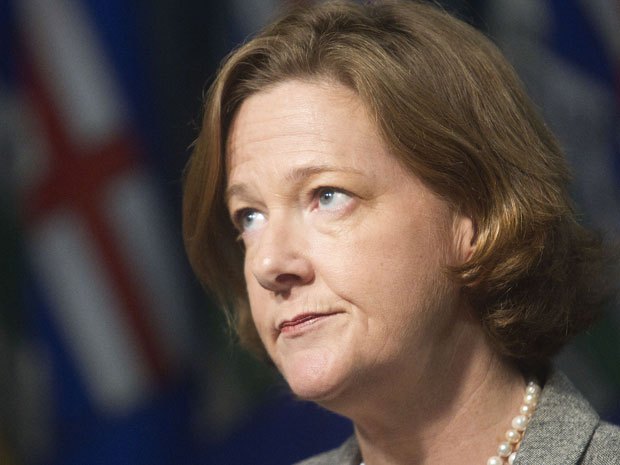The reality is that while education is important, it isn’t everything. Unfortunately, many students don’t seem to realize this going into post-secondary education. The most successful people I know all sought out other opportunities while in school, and shortly thereafter. Many volunteered with political campaigns and NGOs, others blogged (not just for fun), sought out internships relevant to their academic studies, or held down part time jobs.
Year: 2013
Lunch on the Frontier – Manitoba Hydro – With Graham Lane
Listen to Graham Lane speak about Manitoba Hydro at Lunch on the Frontier here. (61 minutes)
Media Release – Think Tank Launches Campaign To Make Sucker Fish Official Manitoba Fish
The Frontier Centre has submitted the Bigmouth Buffalo Sucker as its nominee for the official provincial fish, since the Manitoba government has decided that it would rather hold a fish naming contest than a referendum on the PST increase.
Cox on Urban Sprawl
Creating Satellite Towns to Accommodate Growth Makes Sense.
Featured News
The Compelling Case for Selling Canada’s Water to the U.S.
Canada exports huge quantities of water to the United States and all over the world. As the world’s fifth largest exporter of agricultural products – which are composed mainly of water – huge amounts of Canadian water leave the country every day. Whole lakes are...
Rapidly Evolving Energy Innovation Makes Eco-Extremists’ Apocalyptic Predictions Suspect
A recent Globe and Mail story about a firm developing garbage-to-biodiesel technology shows how continuing progress makes the global warming extremists’ most hysterically apocalyptic predictions, and their extreme absolutist ‘solutions’, not only grossly wrong but...
The “bubble” is not in bitumen
I once heard a wise man say that governments are always wrong when making economic predictions. The questions to consider are by how much, and in what direction?
That the Government of Alberta was wrong in its economic predictions should therefore not be big news. But they were wrong by lots and widely in the wrong direction. Alberta was predicting averages around $99 a barrel for the past year. But it was not that prediction that got them in trouble, now facing a likely deficit near the $6 billion mark.
It appears to be the failure to account for the rising price differential –the difference between market prices and the bargain basement price Alberta needs to sell its oil to the United States because of our lack of pipeline capacity to deliver to markets. It’s what the premier called a “bitumen bubble.” The price differential is not new, and for more than a year, economists were predicting a larger gap unless greater capacity to carry oil to market were developed.
The core of the problem lies elsewhere, whatever the premier says: Two successive Alberta governments for close to a decade have now been unable to balance their budgets at times when oil revenue was riding high. When money abounds and one still runs out of it, it is a clear indication that the problem is not revenue. The problem is spending.
Jack Mintz from the School of Public Policy and other keen observers had predicted that we would be at this precise junction around this time. Keep spending more than you have while you bridge gap with a supply of money the flow of which you cannot control, and it is not difficult to see that when the gap-closing supply goes down so does your ability to keep spending in the same undisciplined way.
And down that hole we now go, raising the spectre of budget cuts and higher taxes. Not quite a cliff, as a friend of mine joked, but surely a Buffalo jump. Yet, the government is still not facing reality for all the reality facing it.
In her televised address last week, the premier keeps promising not to raise taxes, and not to reduce the budget lines of the two largest spending departments, healthcare and education, to deal with the $6 billion gap. Fair enough, but the promise to start putting savings into the Heritage Fund quickly gave her talk a hue of unreality.
Dictating Their Own Fate
Figures on aboriginal population from the 2011 census are not yet available, but the 2006 census showed nearly 1.2 million Canadians — about 4 per cent of the population — claim to be aboriginal. Of these, fewer than a quarter (under 400,000) live on reserves.
Institutionalizing Red Tape Reduction Fosters Bureaucracy
Red tape reduction is not an exclusively Canadian phenomenon, and targets are repeatedly set around the world to reduce administration and regulation. However, the actions taken to meet these targets are not working.
Heritage Property Designations Hindering Religious Liberties?
Religious organizations are noticing that heritage designation laws placed on older church problems are presenting problems for church renovations or necessary demolitions.
Australian Invasion
This week I have an intern, Gen, from Australia working in the Saskatchewan Office with me.
Mandated Light Bulbs, an Unwarranted Health and Environmental Risk
The Hon. John Baird, then Minister of the Environment, in whose watch the mandatory policy for CFLs was adopted.
Among concerns about the health dangers of Compact Fluorescent Light bulbs (CFLs), which contain mercury, the Alberta Government continues to promote the product in its efforts to green itself and the world. The light bulbs are a good example of how elected officials and civil servants –eager to jump on the environmental bandwagon for the sake of political appearances– put people at risk and damage the natural environment in whose name they adopt such misguided policies.
At one website promoting Earth Hour environmental activism, the Alberta Government recommends here that people
Recycle and use compact fluorescent lightbulbs (CFLs). If every household in Alberta changed just one light bulb to a CFL, it would be the same as taking the emissions from 66,000 cars off the road.

One Simple Act, the Alberta Government site promoting the virtues of Earth Hour, passionately recommends the use of the health-hazardous CFLs.
They go on to advise further:
-
Slowly replace all the bulbs in your home. Each time you visit your grocery or hardware store, look for sales and purchase a few more CFL bulbs. Check your electricity bill today, and after replacing 10 lights in your home over one month, check again for energy and cost savings.
-
For all night lighting, you can cut costs by replacing bulbs with lower wattage bulbs or by choosing a compact fluorescent or a nightlight.
In spite of this damning Health Canada report [in pdf] dating back to February 2012, the information the Alberta government offers makes no mention of the significant risks involved.
Sun News Wants to be on Basic Cable
Good commentary from Terry Field on Sun News trying to get on basic cable in a new CRTC proceeding. http://www.troymedia.com/2013/01/25/canadian-tv-consumers-are-still-the-real-losers/ Three things going on here. The first is political. Sun News thinks it represents...
Merit Pay for Teachers Not Such a Bad Thing: Reward teachers for performance
If implemented properly, merit pay is a reform that could be used to reward effective teachers.
Climate Crimes: Green Policies That Are Killing Nature
In his evocative film “Climate Crimes”, the Austrian filmmaker Ulrich Eichelmann who was an active member of WWF for 17 years and worked in conservation for decades, now documents that it is rather the reverse: he shows how many ecosystems, species, habitats and the cultural heritage too are threatened – but, as he sums up, “not by climate change, but by climate protection and the things done in its name.”
